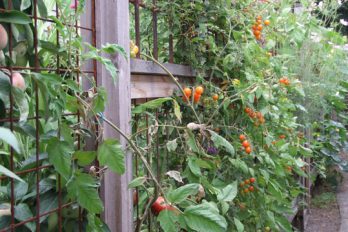Pioneers cleared the land to grow crops to put food on the table. In more modern times, we enjoy the fruits of a multicultural buffet. From pioneer roots to the diversity of contemporary urban and rural agriculture, growing our own food continues to sustain us.
“Early gardeners” says Jannette Porter, “grew vegetables for survival.” Up until about the 1860s, pioneer vegetable gardens, or kitchen gardens as they were called, were either for survival or they were estate gardens.
Ken Willis, Black Creek Pioneer Village’s head gardener, explains that gardens tended to be walled four-square gardens. A wall provided a microclimate to protect tender vegetables and it also extended the growing season. Plots had a north/south path, which bisected an east/west path, dividing the garden into four equal squares for best sun exposure and orderly aesthetics.
According to some sources, it was most desirable to have the paths wide enough for an ox cart to turn around. While today we’re not likely to have an ox cart, much of the gardening knowledge the pioneers brought with them is still relevant. Pioneers practiced crop rotation to prevent infestations of insects such as root worm, believing prevention to be preferable to treatment of an infestation. Composting, or manuring, was composed of one part mineral (ashes, lime, sand or clay depending on soil type), five parts vegetable matter (weeds, straw, bark or sawdust) and six parts animal manure.
Kitchen gardens would have been a mix of vegetables, flowers, fruit and herbs. Varieties we now refer to as heirloom were grown, including sugar pie pumpkin (Cucurbita maxima) and citron melon (Citrullus lanatus). Village gardeners would blanch the stems of cardoon, an artichoke-like vegetable that is an edible thistle, by tying straw ropes around the base to prevent sun exposure. Once the white stems had been harvested, they were marinated overnight in oil, then pan-fried with bread crumbs – yum!
So nowadays when you tuck a few leaf lettuce or cucumber plants in among your roses, it won’t be for mere survival, but you will be part of a continuum of rich garden traditions in Canada.
Jannette Porter, who works at Black Creek Pioneer Village, is very thankful she doesn’t have to grow veggies to survive, but grows some anyway.
Photo credit: Niki Jabbour, author of The Year Round Vegetable Gardener




